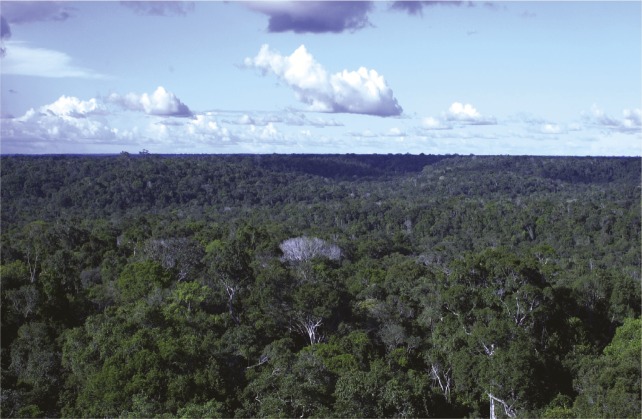Sustainable development in Amazon forests
Expanses of undisturbed tropical forest in the central Amazon, Brazil. Image courtesy of Antonio D. Nobre (National Institute for Space Studies, São José dos Campos, Brazil).
Fifty years of deforestation have converted around 1 million km2 of Amazon tropical forests to agricultural lands, endangering biodiversity and ecosystem functions. Additionally, global warming will likely shift tropical forests toward savanna ecosystems. To study the risks that land-use change, climate change, and development present to the Amazon forest, Carlos Nobre et al. (pp. 10759–10768) modeled the impacts of future climate change and deforestation on the major Amazon biomes. When the model was limited to climate change forcing, Amazon tropical forest coverage for 2050 was predicted to be 15% smaller under a high-emissions scenario, compared with a low-emissions scenario. If the model also included human deforestation and forest fires, present-day Amazon forest coverage was projected to be reduced by greater than 60% by 2050, with eastern and southern Amazon forests converting to seasonal forest and tropical savanna. Furthermore, amounts of deforestation did not correlate with agricultural gross domestic product in Amazonian countries, implying that deforestation-based development may not provide economic growth for those countries. According to the authors, Amazonian nations should sustainably develop the Amazon forests as a source of biological assets and biomimicry designs that could lead to high-value products, services, and platforms for current and new markets. — L.C.
Circadian rhythm, menstrual phase, and sleep
Women are around 1.6 to 2 times as likely as men to experience insomnia. Although the reasons for this predisposition remain unclear, sex-based differences in circadian cycles and hormone expression might play a role. Diane Boivin et al. (pp. 10980–10985) compared sleep–wake cycles in men and women, while controlling for the women’s menstrual cycle phase and use of hormonal contraceptives. The authors tracked core body temperature, melatonin levels, subjective alertness, and polysomnographic measures of sleep in 15 men and 11 women, on average around 25 years of age, and who underwent a 36-cycle protocol consisting of alternating 1-hour waking episodes followed by 1-hour opportunities to nap. Eight of the women were monitored during both the midfollicular and midluteal phases of their menstrual cycles, while three women were monitored during the midfollicular phase alone. The authors found that regardless of menstrual cycle phase, the women fell asleep later in the circadian phase compared with men, and this pattern might potentially influence susceptibility to sleep disturbances. Furthermore, the women in the study scored lower on metrics of nighttime alertness, compared with men, a finding that may help explain why more women than men have difficulty coping with night shift work, according to the authors. — T.J.
Pollen dispersal and climate change adaptation

Pollen dispersal. Image courtesy of Flickr/Matt Batchelor.
Understanding the mechanisms by which plants adapt to climate change is crucial to determining which species will be able to survive climate change. Species may adapt to warming climates by shifting their geographic ranges to follow favorable conditions and by adapting to new conditions. Several models of plant evolution in a warming climate predicted geographic range shifts without changes in the range of habitable temperatures; however, these models ignored the effect of pollen dispersal, which influences gene flow. Robin Aguilée et al. (pp. E5741–E5748) introduced pollen dispersal into existing models to analyze its effect on plants’ responses to climate change. According to the models, increasing pollen dispersal distance slows the speed at which the geographic range changes. However, pollen dispersal also increases the rate at which the population adapts to new temperatures. The results suggest that attempts to predict plants’ risk of extinction or future geographic range under climate change might not be accurate if pollen dispersal is neglected, especially for species in which pollen disperses significantly farther than seeds. The results also suggest that pollen dispersal might allow plants to survive a faster rate of climate change than in the absence of pollen dispersal, according to the authors. — B.D.



